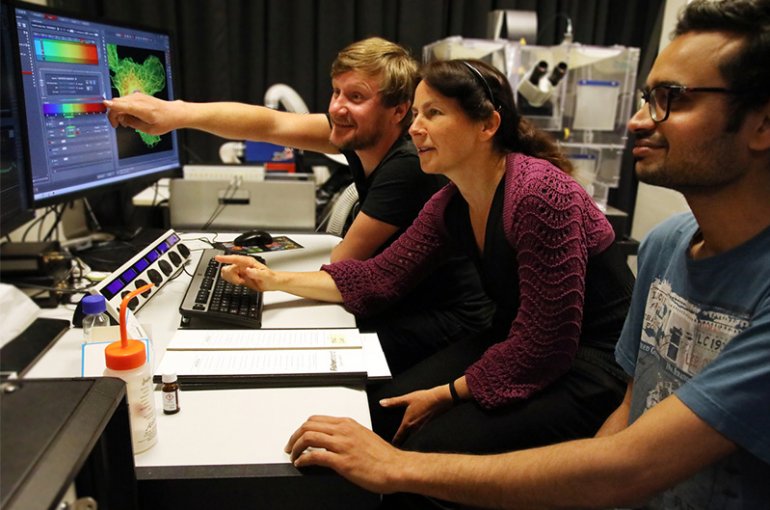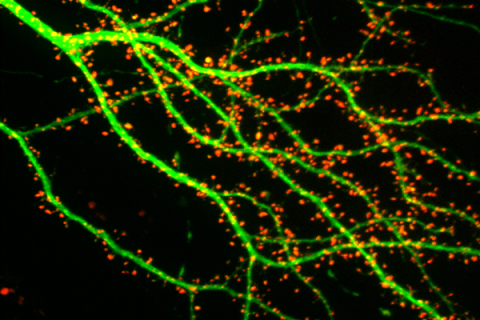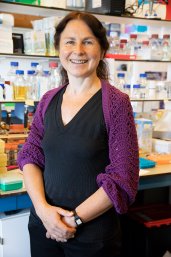How the building blocks of the cell are linked
‘This is a great time to be a molecular biologist’

Text & Photography: NWO; text Nienke Beintema, photography Rafaël Philippen
Anna Akhmanova studies how structures in living cells build themselves using of individual building blocks. This knowledge can help us to develop better medicines. ‘Ultimately we want to be able to guide this self-building process,’ says the Professor of Cellular Dynamics at Utrecht University. Akhmanova receives a Spinoza Prize worth 2.5 million euros for her work.
You’re originally Russian. How did you end up in the Netherlands?
‘I graduated as a molecular biologist from Moscow State University in 1989. That was a period of enormous change in Russia. The Soviet Union was falling apart and we ended up in a financial crisis. Funding for science came to a standstill. Many scientists of my generation went abroad during that time. I had a look around as well. I ended up in Twente on a scientific exchange programme. From there I looked for a PhD position. There were various options. I eventually chose Nijmegen.’
How did you like it there?
‘It was very pleasant there. It was a nice lab with a good atmosphere. I soon began to speak Dutch with my colleagues in the lab. They gave me great support there, and I learned a lot. After that I stayed in the Netherlands, because I saw sufficient opportunity to develop myself here. That was the most important criterion for me. And the research climate was appealing. I really consider myself to be a Dutch scientist now.’

You’re studying the cytoskeleton. What exactly is that?
‘You can compare it to our skeleton, but then at the cell level. It supports the cell, gives it its shape and enables it to move. The cytoskeleton is a system of microscopic tubules (microtubules) and filaments found in all cells: in bacteria, plants, animals and so also in human beings. The biggest difference with the human skeleton is that it’s not so static. Parts of it are constantly being built and broken down. My research focuses on the question of how that all works, and how the cell, thanks to these dynamic changes, can do all sorts of things, such as divide itself into two, move, and adapt to its environment.’
Can you give an example?

‘Cell division is an excellent example. First, chromosomes, the carriers of genetic information, gather in orderly fashion in one area. The chromosomes duplicate, after which their two halves are pulled apart and distributed across two daughter cells. That entire process is guided by these tubules and filaments in the cytoskeleton.'
'Another example is the transport of proteins and cell constituents in the cell, which occurs through the tubules of the cytoskeleton. We would like to know how that works.’
Why is that important to know?
‘If you know how a cell builds or breaks down these structures, then you can try to guide that process. Sometimes you want to inhibit this process, for example with cancer cells that divide too quickly. If you know what role the cytoskeleton plays in different types of cells, then you could perhaps design cancer therapies that only attack tumour cells.’
The cytoskeleton resembles structures that people can make, such as buildings or networks of roads. But the cell doesn’t have a masterplan, as we do. So how does the cell do it? How does it ensure that the right molecule links up in exactly the right way?
Are there diseases that are related to deviations in the cytoskeleton?
‘Yes, certainly. A very concrete example is an eye disease that originates when a nerve has not grown properly. The eyes of patients with this disease are turned permanently downward. We have discovered that these people have a mutation in a protein that regulates the growth of the cytoskeleton. This knowledge could open up new prospects for treatment in the future.
‘There are also afflictions related to the polarity of the cell. Many cells have two different sides: for example, a side that absorbs substances and a side that emits substances. The cytoskeleton regulates this polarity. Indeed, the transport of substances through the tubules of the cytoskeleton only goes in one direction. Faulty polarity can lead to deviations, for example uncontrolled cell division.'
'In Alzheimer’s Disease, a protein is disrupted that binds microtubules in healthy nerve cells. In affected cells it accumulates elsewhere. And a disruption of the transport of motor neurons can lead to ALS-type diseases.’
You’re much more involved in the fundamental side.
‘Yes. As a scientist I am especially fascinated by the question of how cells build themselves. The cytoskeleton resembles structures that people can make, such as buildings or networks of roads. But the cell doesn’t have a masterplan, as we do. So how does the cell do it? How does it ensure that the right molecule links up in exactly the right way? It’s a magnificent type of self-building with molecular building blocks. Ultimately we would like to be able to guide this self-building.’
How do you actually study self-building?

‘The fun part is that you can follow the dynamics of the cytoskeleton very closely under a microscope. You actually see what’s happening in real-time. For example, using genetic techniques we can embed fluorescent labels in certain parts of the cell.'
'And we can turn off specific genes. Then we can monitor exactly what changes in the cell, and thus deduce what certain genes do. And how we can guide these processes, for example by adding certain substances.'
‘What I also real like about it is that we work with other scientific disciplines. Together we can improve our understanding of how biological structures are linked to each other, and attempt to mimic this self-building. In this area I work closely with Marileen Dogterom, who also received a Spinoza Prize this year. She is studying the physical side of the cytoskeleton.’
What are you going to do with the 2.5 million euros?
‘Perhaps it’s a little too early to say. But in general I want to understand this process of self-building better – together with Marileen Dogterom, for example, on the interface of cell biology and biophysics. These two Spinoza Prizes are definitely going to help in that respect.
'As for myself, I want to create a complete picture of all molecules involved in self-building. A kind of animation of all processes that occur simultaneously and of the role that each molecule plays in them.'
'You may be familiar with the famous animated video from Harvard, The Inner Life of the Cell, in which a motor protein with two feet walks across a microtubule. That video shows a small piece of a biological process. We would like to make similar videos, but in much more detail, with hundreds of molecules.’
What is the added value of that?
‘Every medicine binds to one of these molecules somewhere. If you improve your understanding of how all of these things are linked, then you can design medicines with a more specific and targeted effect. And that will enable you to find out where cancer medicines strike, also at the level of individual molecules. And whether there are molecules that perhaps fit better.’
Isn’t there a great deal of speculation involved in that?
‘Yes, to a certain extent, but that’s true of every link in the science chain. Knowledge is never absolute. And never complete. But based on the best available knowledge, you can say: this part is definitely true, and we invented this part so the story makes sense.'
'With new techniques it’s increasingly possible to work on small pieces of the puzzle. And in five years, someone else will come along with a new technique that enables us to do it even better. This is happening all the time. That’s why biology is so enthralling, because there’s still a lot happening. So there’s new knowledge emerging at an incredibly fast pace. This is a great time to be a molecular biologist.’
There’s also a revolution underway in genetics. How does that affect your work?
‘Thanks to new genetic techniques, in particular CRISPR-Cas9, we can design the building blocks with extreme precision. So that they do bind with four proteins, for example, but not with a fifth. And we can find out exactly which building blocks are needed to ensure that the cytoskeleton is constructed and functions in the right way.'
'CRISPR-Cas9 has really put all of this within reach. We’ll able to make a direct link now: gene X is needed to get the microtubule to grow fast, so if we alter this gene then we can slow down that growth.’
You sound very optimistic!

‘Yes, I’m a huge optimist. We now have fantastic techniques at our disposal. We can really adapt anything with extreme precision. It’s now up to us to discover what precisely we need to adapt to get a cell to behave in a certain way. There’s still a great deal to discover. That optimism, and the curiosity – I like to convey that to young researchers. The affinity between research and teaching is extremely important to me.’

